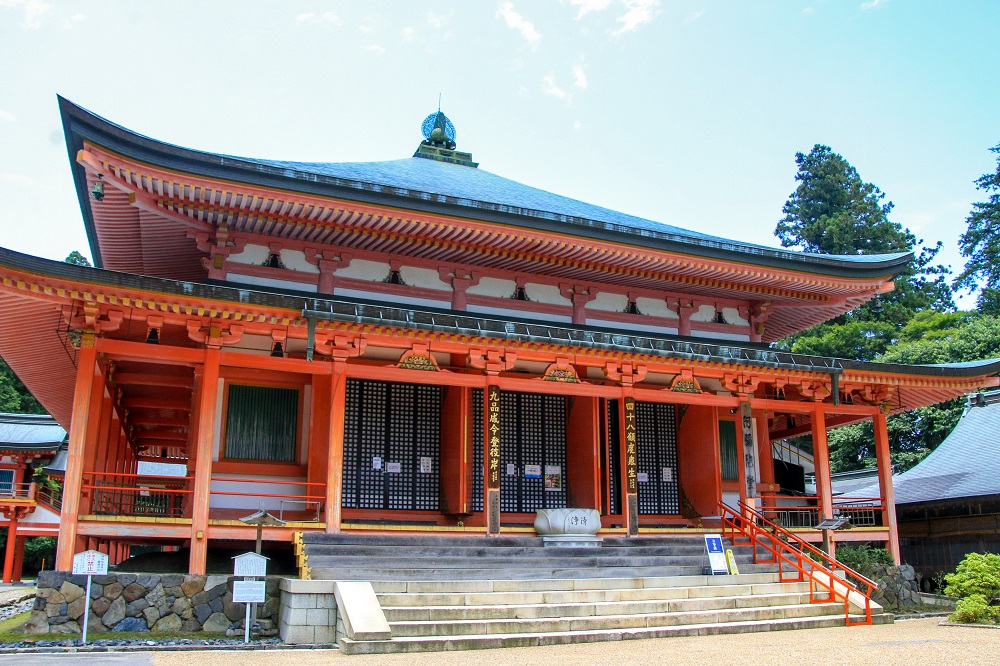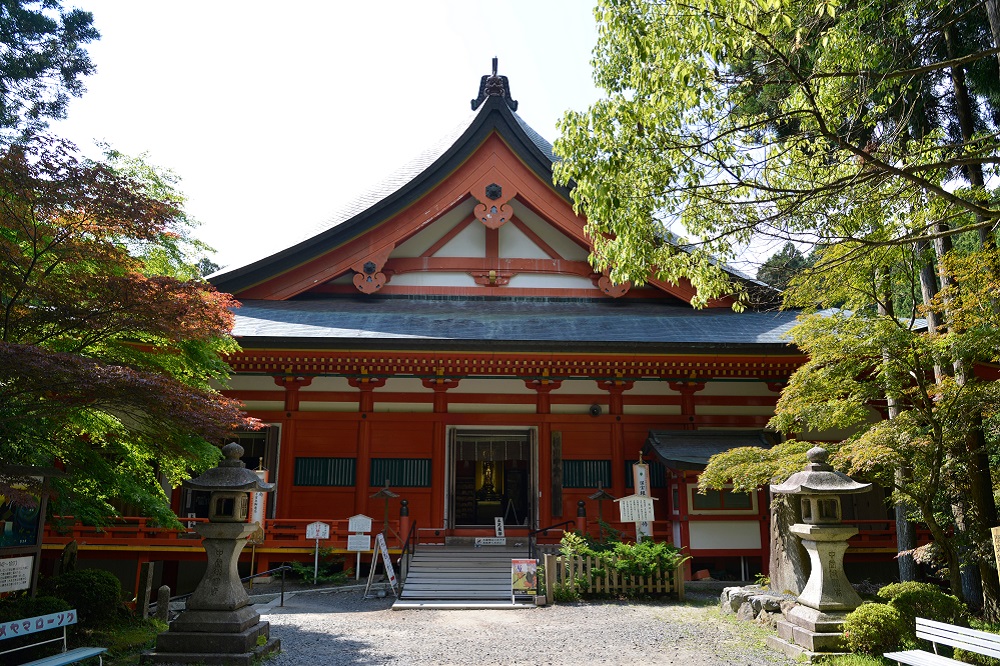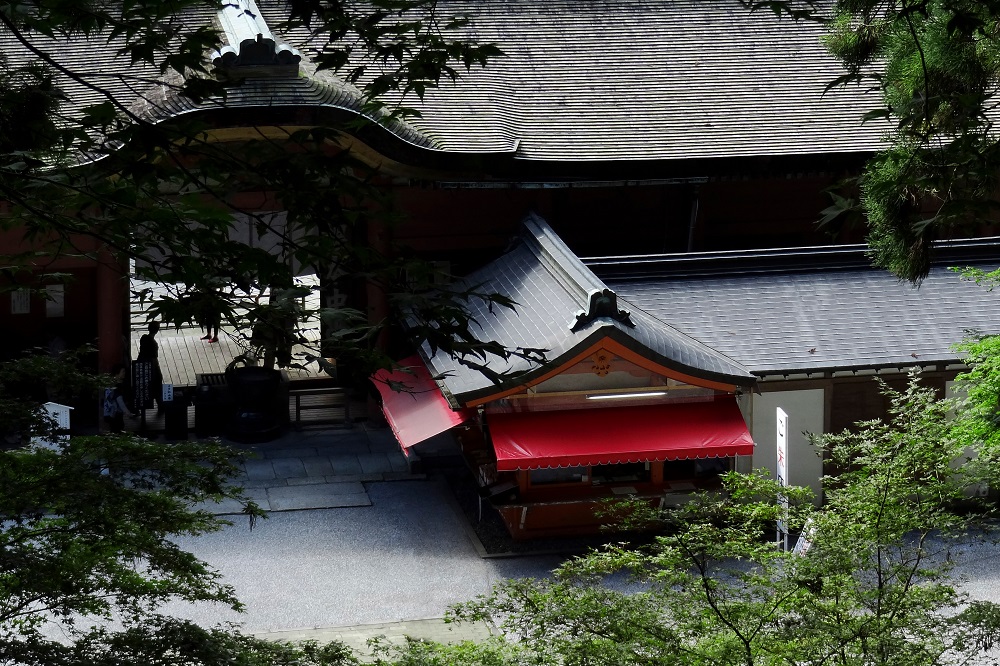Enryakuji Temple is the head temple of the Tendai sect of Buddhism in Japan and has the vast temple area stretching out across Mt. Hiei. The temple is said to have been founded at the end of the Nara Period in 785, by a monk named Saicho (767-822), who climbed Mt. Hiei and had a hermitage set up. Enryakuji is an extremely prestigious temple that has reigned supreme in the Japanese religious world for some 1,200 years and has produced founders and high priests of each sect of Japanese Buddhism.

Saicho, the founder of the Tendai sect of Buddhism, was born in 767 in Sakamoto (Otsu City, Shiga Prefecture of today). At the age of 14, he ordained as an official monk acknowledged by the country, and the name "Saicho" was given. He then went to Nara, the capital city at the time, and devoted himself to religious training and study. After becoming a full-fledged monk officialized by the country, instead of moving on with the path to enlightenment at the great temple, Saicho returned to hometown and continued training by practicing asceticism on Mt. Hiei. In 804, during the ongoing training in Mt. Hiei, Saicho decided to study the Tendai Doctrine even deeper and went to China. When he returned to Japan, Saicho worked hard to spread Japan wide of the Tendai spirit based on the "Lotus Sutra", that all persons are able to be Buddhas. In 806, two monks were authorized by the state and the Tendai sect was officially recognized. After his death, Saicho was given the posthumous title "Dengyo Daishi" by Emperor Seiwa. "Daishi" meaning "great leader who teaches and guides others” and was marked as the first in Japanese History to be honored with the title.

"Enryakuji" is a collective name for about 100 temples spread throughout 1,700-hectare precincts on Mt. Hiei and is not the name for a single structure. Mt. Hiei is classified into three areas, the To-do [East Pagoda] area to the east, the Sai-to [West Pagoda] area to the west, and the Yokawa area to the north, each area with its own Chu-do [Main Buddhist temple building]. The To-do [East Pagoda] area is the birthplace of Enryakuji Temple, where Dengyo Daishi Saicho opened the first of the temple buildings, Konpon Chu-do, and is the beating heart of all three areas of the temple precinct. The Konpon Chu-do [main temple] is a national treasure, and a concentration of other important buildings, including large halls dedicated to the founders of each of the sects of Buddhism, are at To-do [East Pagoda].

Sai-to [West Pagoda] is the area centering around the Shakado Hall [Main Hall]. Shakado Hall is one of the oldest existing structures in the Enryakuji Temple and is designated as the National Important Cultural Property. Shakado Hall was originally the main temple of the Enjoji in Mii Temple and was relocated by Toyotomi Hideyoshi in 1595. Other structures are Jodoin, a mausoleum for Saicho, the founder of Enryakuji Temple, and Hokkedo [Ninai-do], a temple for ascetic practices.
Yokawa is the area centering around the Yokawa Chu-do [Main Hall], characterized by stage construction, with the overall appearance of a floating boat. The Yokawa area is also the location of Shiki Kodo [Gensan Daishi Hall], which is said to be where "omikuji" [fortune paper] originated, as well as Keishindo, where Monk Genshin, author of "Ojoyoshu, an influential medieval Buddhist text, lived.
to Kyoto
■From Tokyo and Nagoya
Board the JR Tokaido Shinkansen (Bullet Train) and disembark at JR Kyoto Station.
[Duration: From Tokyo-approx. 2 hours and 18 min., From Nagoya- approx. 36 min.]
From Kyoto To Mt. Hiei
■From JR Kyoto Station
Board the JR Nara Line to Tofukuji Station, transfer to Keihan Main Line and disembark at Demachiyanagi Station. Transfer to the Eizan Railway Eizan Line and disembark at Yase-Hieizanguchi Station. Transfer to the Eizan Cable Car and Ropeway and disembark at Mt. Hiei Summit Station.
■From Kyoto Station
Take either Keihan Bus or Kyoto Bus [Mt. Hiei Drive Bus]. Either of the bus will take you to the Enryakuji Bus Center directly in about 60-70min.)
*No operations during winter.
Enryakuji was registered as a World Heritage Site in 1994 and is one of the component parts of the "Historic Monuments of Ancient Kyoto (Kyoto, Uji and Otsu Cities)". The temple is highly regarded for a history of 1200 years and traditions, along with the Kiyomizu-dera Temple and Rokuon-ji [Kinkaku-ji Golden Pavilion] in Kyoto. Numerous buildings comprise Enryakuji, including the National Treasure Konpon Chu-do, designated Important Cultural Properties.

A facility for storing Buddha statues, Buddhist paintings, and calligraphy and other cultural properties that have been handed down to Enryakuji. Many of them have been designated as national treasures and important cultural properties, and you can get a glimpse of the history of Enryakuji. The name “National Treasure Hall [Kokuhoden]” derives from the phrase, “'Shine a light on a corner. It would be a national treasure.'”, in "Rules for Students in the Mountain Monastery (Sangegakushoshiki)” the book written by Denkyo Daishi Saicho. The teaching of Saicho, is that a "national treasure" is not an object, but the heart of a person.
Ruri-do is the only building which was not burnt down during the attack with fire by Oda Nobunaga to siege Mt. Hiei to unify the country. The main deity is Yakushi Ruriko Nyorai, the Buddha of healing and medicine. Ruri-do is said to have been built in the late Muromachi Era (1336-1573), with the architectural style of the Tang style which is a rarity on Mt. Hiei and is designated an Important Cultural Property of Japan.
If you are planning to visit Mt. Hiei and Enryakuji Temple by cable car or ropeway, we recommend the "Hieizan Free Pass". This pass includes unlimited rides on the Eizan Railway between Demachiyanagi Station and Yase Hieizanguchi Station, Eizan Cable Cars and Ropeway, Hieizan Shuttle Bus [operating between Mt. Hiei and Yokawa], Sakamoto Cable Car and Ejaku Bus [between Cable Sakamoto Station to Hieizan Sakamoto Station] for one day and access to parts of the Enryakuji Temple. This pass will help you travel smoothly around the Enryakuji Temple and is excellent in value compared to purchasing tickets individually.